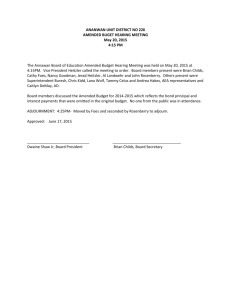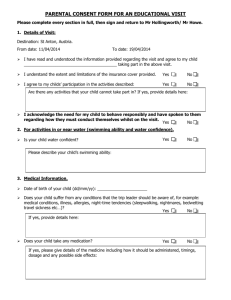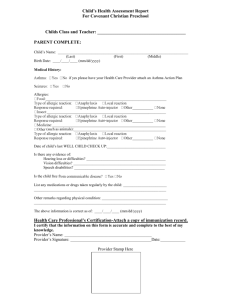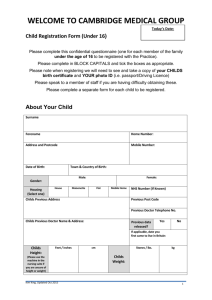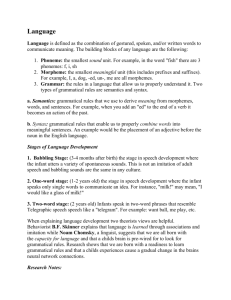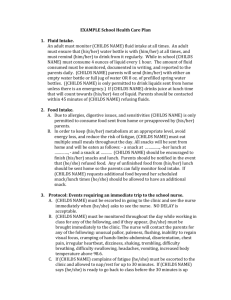CHILDS Hayden William - Courts Administration Authority
advertisement
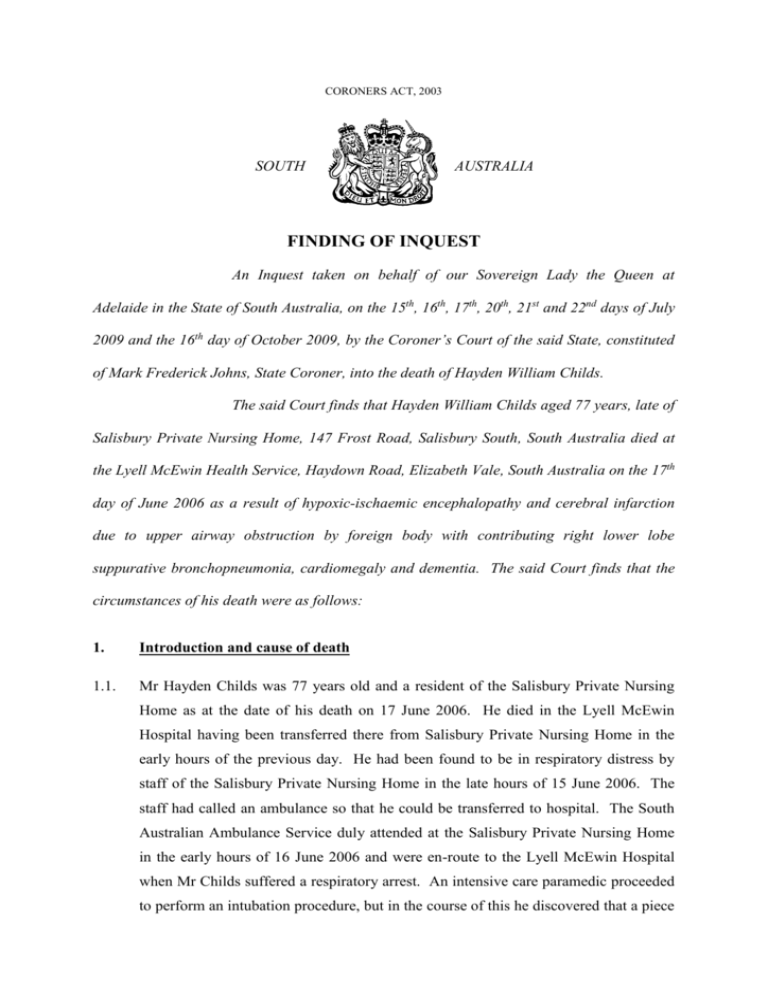
CORONERS ACT, 2003 SOUTH AUSTRALIA FINDING OF INQUEST An Inquest taken on behalf of our Sovereign Lady the Queen at Adelaide in the State of South Australia, on the 15th, 16th, 17th, 20th, 21st and 22nd days of July 2009 and the 16th day of October 2009, by the Coroner’s Court of the said State, constituted of Mark Frederick Johns, State Coroner, into the death of Hayden William Childs. The said Court finds that Hayden William Childs aged 77 years, late of Salisbury Private Nursing Home, 147 Frost Road, Salisbury South, South Australia died at the Lyell McEwin Health Service, Haydown Road, Elizabeth Vale, South Australia on the 17th day of June 2006 as a result of hypoxic-ischaemic encephalopathy and cerebral infarction due to upper airway obstruction by foreign body with contributing right lower lobe suppurative bronchopneumonia, cardiomegaly and dementia. The said Court finds that the circumstances of his death were as follows: 1. Introduction and cause of death 1.1. Mr Hayden Childs was 77 years old and a resident of the Salisbury Private Nursing Home as at the date of his death on 17 June 2006. He died in the Lyell McEwin Hospital having been transferred there from Salisbury Private Nursing Home in the early hours of the previous day. He had been found to be in respiratory distress by staff of the Salisbury Private Nursing Home in the late hours of 15 June 2006. The staff had called an ambulance so that he could be transferred to hospital. The South Australian Ambulance Service duly attended at the Salisbury Private Nursing Home in the early hours of 16 June 2006 and were en-route to the Lyell McEwin Hospital when Mr Childs suffered a respiratory arrest. An intensive care paramedic proceeded to perform an intubation procedure, but in the course of this he discovered that a piece 2 of cloth was occluding Mr Childs’ airway. The cloth was only visible upon examination by use of a laryngoscope in preparation for the insertion of an endotracheal tube. The paramedic used forceps to remove the cloth and discovered that it was in fact a handkerchief. Upon removal the handkerchief was tightly compacted into an approximately cylindrical shape, mimicking the shape of the airway. The occlusion of Mr Childs’ airway by the handkerchief had been the cause of his respiratory distress. As a result of the occlusion, Mr Childs’ brain was starved of oxygen and he suffered cerebral hypoxia. He was examined in the Emergency Department. The diagnosis of hypoxic brain injury was made and he was given comfort care until his death the following day. A post-mortem examination was conducted and the pathologist gave the cause of death as hypoxic-ischaemic encephalopathy and cerebral infarction due to upper airway obstruction by foreign body with contributing right lower lobe suppurative bronchopneumonia, cardiomegaly and dementia and I so find1. 1.2. The Inquest was primarily focussed on the question of how the handkerchief came to be lodged in Mr Childs’ airway. To assist in answering that question, the events of 15 June 2006 were extensively explored and evidence was taken from staff, both carers and nurses, who had contact with Mr Childs that day. Some of the staff were permanent employees of Salisbury Private Nursing Home and some were provided by an agency known as BDS Recruit. 2. Mr Childs’ medical history 2.1. I heard evidence from Mr Childs’ treating general practitioner, Dr Taylor. Significantly Dr Taylor had attended at the nursing home in the late afternoon of 15 June 2006 to examine Mr Childs. I will come to that examination later in this finding. Dr Taylor helpfully outlined Mr Childs’ general medical condition as follows. He suffered from hypertension and chronic bronchitis. He had previously abused alcohol and had many admissions to Glenside Hospital and the Queen Elizabeth Hospital for that problem. He had a significant degree of dementia for several different reasons. He had a disturbance of cerebral function resulting in an unstable gait and poor muscle control. He lost his left eye through a traumatic incident and had glaucoma of the right eye and virtually no vision in the last few years of his life. emphysema and was depressed. 1 See Exhibit C1a, post-mortem report by Dr Cala He had He had psychotic behavioural disturbance, 3 prostatism and incontinence of both bowel and urine function. He had osteoarthritis of his knees and was subject to seizures which were presumed to be secondary to head trauma. He had two previous documented cerebrovascular accidents in 1973 and 1976 and Parkinsonism secondary to anti-psychotic medication. He had oro-facial dyskinesia, a common side effect of prolonged use of certain anti-psychotic drugs. 2.2. Dr Taylor described Mr Childs as a frail man who, for at least 12 months prior to his death, was more or less confined to either a wheelchair or bed. He was resistive to any form of physical examination, particularly of his ears, eyes or mouth and it was difficult to examine him because of his resistive movements of the arm and head. 3. Mr Childs’ family 3.1. Evidence was given by Mr Childs’ daughter, Ms Curtis. She lives in Queensland and had been in the habit of visiting South Australia every year to see her father. She would also regularly call him and speak to him on the telephone. However, in 2004 he suffered two strokes, as a result of which his level of functioning decreased to the point where he was unable to communicate by telephone. Thereafter, she would ring the nursing home every 6 to 8 weeks to enquire about his wellbeing and continued with her yearly visit. 3.2. Ms Curtis gave some evidence about a visit to the nursing home in November 2005. She was critical of the circumstances in which she found her father at that time. I was urged to reject this evidence by counsel for Salisbury Private Nursing Home for reasons I need not set out. The circumstances of November 2005 do not throw any light upon the peculiar circumstance of 15 June 2006 in which the handkerchief came to be lodged in Mr Childs’ airway and accordingly, I do not need to discuss this issue further. 4. The morning of 15 June 2006 4.1. Mr Penning was a carer employed by BDS Recruit and was assigned to work at Salisbury Private Nursing Home on 15 June 2006. He had worked at Salisbury Private Nursing Home some 15 to 20 occasions previously2. On 15 June 2006 he was assigned to the dementia side of the ward in which Mr Childs was a resident. He was told his duties by another carer called Beverley. He shaved, showered and dressed Mr 2 Transcript, page 122 4 Childs. He requested that the other carer provide him access to Mr Childs’ locked wardrobe in order that he could retrieve Mr Childs’ clothing. The other carer unlocked the wardrobe for Mr Penning and he removed the necessary clothing. He said that he noticed that in the wardrobe there were a number of handkerchiefs, all folded up. He took one of those and placed it in Mr Childs’ breast pocket. Mr Childs was wearing a flannelette shirt with a windcheater over the top. He was wearing tracksuit pants3. The handkerchief that was retrieved from Mr Childs’ airway was admitted as Exhibit C25. The exhibit was shown to Mr Penning and he identified it as being very similar to the handkerchief he provided to Mr Childs4. For reasons which will become apparent later in this finding, it is not possible to be certain that the handkerchief that Mr Penning placed in Mr Childs’ pocket was exactly the same handkerchief that was subsequently extracted by the intensive care paramedic. However, for the reasons which are set out in this finding, I find on the balance of probabilities that it was the same handkerchief. 5. Mr Childs’ propensity for placing objects in his mouth 5.1. In general, Salisbury Private Nursing Home permanent staff knew that Mr Childs had a habit of putting things in his mouth and that small objects should be kept away from him. For example, buttons were removed from his clothing5. Ms Kiran Dhillon, a registered nurse permanently employed by Salisbury Private Nursing Home, commented that most of the staff knew Mr Childs because he had been at the home for many years and they knew that he was capable of putting items into his mouth6. 6. Mr Childs’ care plan 6.1. There was at Salisbury Private Nursing Home a document created in relation to every resident known as a care plan. Indeed, this is a universal practice in the aged care sector. Mr Childs’ care plan was admitted as Exhibit C16 in these proceedings. The only reference to his habit of placing things in his mouth appears under the part of the care plan dealing with dietary and nutrition issues. That entry describes his diet 3 Transcript, page 105 Transcript, page 121 5 Transcript, page 216 6 Transcript, page 216 4 5 which is to consist of soft vitamised meals. It says that he likes large meals and eats well. Under the heading ‘Interventions’ it states: 'Explain meal time to Hayden. Do not leave any food within Hayden’s reach as he will put everything in his mouth.' 6.2. The care plan was required to be reviewed on a regular basis. The entry to which I have just referred was last reviewed on 16 January 2006 prior to Mr Childs’ death; therefore more than 6 months had expired since this aspect of the care plan was reviewed. 6.3. Mr Barry Lowe, the Executive Officer of the Salisbury Private Nursing Home, gave evidence and acknowledged that it was unacceptable that Mr Childs’ care plan was not reviewed between January and July 2006. 6.4. It was also notable that the care plan did not make any other reference to the need to keep small items away from Mr Childs in case he placed them in his mouth and choked on them. It seems to me that any such warning should have been placed in some more obvious location within the care plan than under the heading of dietary and nutrition. For example, it might have been placed under the heading of ‘behaviours’ or ‘risky behaviours’. In a sense, this point has been acknowledged by the actions of Salisbury Private Nursing Home since Mr Childs’ death. Risky behaviours are now recorded on the front page of the care plans of residents at the nursing home in a place where they are easily and quickly located. 7. The morning of 15 June 2006 7.1. Mr Penning, being employed by BDS Recruit, was not aware of Mr Childs’ propensity to place things in his mouth. He did not refer to the care plan and gave evidence that it was not compulsory for an agency carer such as he was to look at the care plan7. 7.2. Mr Penning’s evidence was that he saw the handkerchief in the wardrobe as he was dressing Mr Childs and he assumed that he was allowed to use it 8. Another employee of BDS Recruit, Kristy Castle, also worked the morning shift on 15 June 2006. She saw Mr Childs shortly after morning tea and gave him a drink. She explained that the 7 8 Transcript, page 110 Transcript, page 110 6 drink disappeared for a little while but then came back up. She also described it as ‘dribbling straight back out’9. Ms Castle also noted a noise from Mr Childs’ chest which she also thought was unusual10. 7.3. Ms Castle reported these observations to enrolled nurse Leanne Palmer who was another employee of BDS Recruit. Ms Palmer had already seen Mr Childs earlier that morning when she gave him his morning medications. When she was approached by Ms Castle she went to Mr Childs and carried out an assessment of him. She noted the problems with his drinking. She formed the opinion that he was having respiratory problems, although he was not in distress11. 7.4. Ms Palmer then decided to raise the matter with Ms Dhillon. Ms Dhillon directed that Mr Childs be moved to the communal area where he could be observed. 7.5. Mr Penning next saw Mr Childs at lunchtime. Mr Penning attempted to feed Mr Childs his lunch and noted that his lunch came straight back up after it was fed to him and that this applied to both food and drink. Mr Penning believed that something was wrong with Mr Childs and reported the matter to one of the nurses. 7.6. At about this time, the matter was brought to the attention of Ms Dhillon who performed suctioning upon Mr Childs. At first she tried to use a hard tube suction device known as a yanker sucker but Mr Childs kept pushing it away and would not cooperate. She then used a softer tube and was able to introduce it to his mouth by the side of his mouth. She introduced the tube approximately 5 centimetres into his mouth and said that she succeeded in removing mucus from his mouth. She did not make a record of the suctioning herself in the notes that day, intending to do it the following day. 7.7. Ms Palmer made a note about this event. She made a note at the end of her shift that suctioning was performed but ‘with little effect’. Ms Dhillon countersigned this note and intended to write a fuller report in the notes the following day. 7.8. Ms Dhillon said that she thought that Mr Childs was not in distress and his breathing was normal. She contacted Dr Taylor around lunchtime and asked that Dr Taylor attend to check on Mr Childs because she believed he might have a chest infection. 9 Transcript, page 137 Transcript, page 138 11 Transcript, page 186 10 7 8. The afternoon of 15 June 2006 8.1. In the late part of the afternoon Dr Taylor attended as requested by Ms Dhillon. He examined Mr Childs and formed the view that he had a possible bronchitis or pneumonia. He could not remember specifically inspecting Mr Childs’ mouth but noted that Mr Childs was normally resistive to such examinations. Dr Taylor made notes in the nursing home records. He referred to a chesty cough and that Mr Childs was not cyanosed on examination. He prescribed antibiotics. There was no indication to Dr Taylor that there was any obvious upper airway obstruction. Dr Taylor noted that Mr Childs was breathing through his nose. He said that it was highly unlikely that there was anything in Mr Childs’ mouth at the time of the examination. He said that if there had been anything in Mr Childs’ airway at the time his breathing would have been rapid and there would have been some degree of cyanosis. However, Mr Childs’ breathing was quite regular and not increased in rate. In short, there was nothing to suggest to Dr Taylor that there was anything in Mr Childs’ mouth at the time of his investigation. In general, there was nothing untoward other than the diagnosis Dr Taylor had made. 8.2. During the early evening of 15 June 2006 enrolled nurse Cynthia Winchester, a permanent employee of Salisbury Private Nursing Home, gave Mr Childs his regular medications. She recorded having done this at 1700 hours and 2000 hours and gave evidence that the medications were duly taken as recorded in the charts. 9. Conclusions as to presence or absence of handkerchief in Mr Childs’ airway at mid evening on 15 June 2006 9.1. It seems plain on the evidence that the handkerchief was not in Mr Childs’ mouth or airway for the whole of the period between when he was dressed in the morning by Mr Penning and mid evening of the same day. It is true that there is evidence that Mr Childs was having trouble consuming his lunch, that this was noted by Mr Penning, and Ms Palmer and Ms Dhillon performed suctioning. However, the difficulties being experienced by Mr Childs in the morning could be readily explained by the fact that he was suffering from a chest infection and not an obstruction in his airway or throat. Bearing in mind that he was seen by Dr Taylor, an experienced general practitioner late in the afternoon, and that Ms Winchester experienced no difficulties in administering his medications in the late afternoon, there is no other logical 8 conclusion than that the handkerchief was not in Mr Childs’ mouth or airway at that time. If it was not present in the late afternoon of 15 June 2006 then there is no reason to assume that it was present in his mouth or airway at an earlier time than that. 9.2. The location of the handkerchief during the day remains a mystery in this matter. On at least one occasion during the day, Mr Childs’ upper clothing was changed because it was wet from saliva as a result of his dribbling. It is surprising that the handkerchief was not detected at that time, or removed with his shirt. However, it is possible that the handkerchief had been moved by Mr Childs into the pocket of his tracksuit pants and that it remained in his tracksuit pants or somewhere else in his vicinity throughout the rest of the day. Indeed, it must have done so because there was no question that it was introduced into his mouth at some point in the second half of the evening of 15 June 2006. 10. Mr Childs’ collapse 10.1. Christina Hamilton was employed by Salisbury Private Nursing Home as a carer. She worked the nightshift commencing at 10:30pm on 15 June 2006. At around 11:30pm she entered Mr Childs’ room and observed that he was a ‘different colour’12 and that his fingertips were purple. She thought his breathing sounded funny. She had been told that he had been suctioned during the day. She left Mr Childs and sought the assistance of enrolled nurse Alexina Blackie who was on duty that evening. 10.2. Ms Blackie was employed by Salisbury Private Nursing Home as an enrolled nurse. She also was working on the nightshift on 15 June 2006. She was aware that Mr Childs had been rattly in his breathing that day and had been suctioned during the morning and afternoon shifts. Her recollection was that she and Ms Hamilton went to check on Mr Childs shortly before midnight. They raised him in the bed and turned him on his left side to make sure that any mucus in his mouth would be able to escape. They tilted his head downward and Ms Blackie performed some suctioning of his mouth. She said that she used a flexible suction device and did not go further than Mr Childs’ mouth. 10.3. Ms Blackie then requested that Ms Hamilton go and summon the registered nurse. The registered nurse on duty that night was Mr Pradeep Rathore, who is employed by 12 Transcript, page 268 9 BDS Recruit. He gave evidence that when he went into Mr Childs’ room the suction machine was running. He said that it was fitted with a hard plastic yanker sucker when he entered the room. He identified Exhibit C28b, a yanker sucker that was seized by police officers from Mr Childs’ room in the early hours of 16 June 2006 as being identical to the yanker sucker he used on Mr Childs. 10.4. I note that there is an inconsistency between the evidence of Ms Blackie and Mr Rathore in that the former gave evidence that there was no yanker sucker in the room. Her evidence was that she later saw a yanker sucker ‘getting soaked’ 13 in the laundry or sluice room. When it was pointed out to her that the yanker sucker is a disposable device, she was unable to explain why it would be left to soak. In any event, I am left in no doubt, having heard Mr Rathore, that the suction device employed by him was the hard plastic yanker sucker. 10.5. Mr Rathore said that he performed suctioning upon Mr Childs and then placed an oxygen mask over his mouth. He then suctioned Mr Childs once again using the hard plastic yanker sucker on the second occasion also. According to Mr Rathore, Mr Childs’ condition became worse after the suctioning. He said that he placed the tube approximately 6cm to 7cm into Mr Childs’ mouth. He made a statement in which he said that he placed the tube as far back as the back of Mr Childs’ teeth14, but when it was pointed out to him that Mr Childs did not have teeth, he was unable to explain why he made that remark in his statement. He acknowledged that he did not see inside Mr Childs’ mouth when performing the suctioning. He acknowledged that he thought that Mr Childs may have been choking on something when he did not respond to the administration of oxygen. 10.6. Ms Blackie was asked by Mr Rathore to call an ambulance at this stage. She did that promptly and the relevant South Australian Ambulance Service report form15 shows that the ambulance was summoned at 0033 hours. It arrived at the Salisbury Private Nursing Home at 0045 hours and departed at 0058 hours. 10.7. Intensive care paramedic Aaron Turner gave evidence at the Inquest. He said that on arriving at Mr Childs’ room he looked extremely unwell and that he was in a reduced conscious state, his hands were blue and he was extremely short of breath. Mr Turner 13 Transcript, page 287 Exhibit C4a 15 Exhibit C31b 14 10 placed Mr Childs on high flow oxygen and then summoned a second ambulance. A cardiac monitor was placed on Mr Childs and the ambulance crew performed a rapid extrication because of their assessment that they needed to get Mr Childs to hospital urgently. They loaded him into the ambulance and, at that point, the second ambulance arrived. Mr Turner stayed with Mr Childs in the rear of the first ambulance and they left for the Lyell McEwin Hospital. 10.8. While en-route to the Lyell McEwin Hospital, Mr Childs’ heart rate dropped from 100 beats per minute to 50 beats per minute, his breathing from 12 respirations per minute to 6 respirations per minute and his Glasgow Coma Score was 3. Mr Turner decided to perform an intubation and used a laryngoscope to pull Mr Childs’ tongue forward in preparation for the intubation. At that point he noted an obstruction at the laryngeal level. Using forceps he pulled out the handkerchief. He then performed the intubation and Mr Childs’ condition improved immediately. The ambulance arrived at the Lyell McEwin Hospital at 1:08am and Mr Childs was handed over to the Emergency Department staff. 10.9. Mr Turner had thought that the police should be notified because the position of the handkerchief appeared to him to be ‘suspicious’16. 11. Emergency Department - Lyell McEwin Hospital 11.1. Dr Lee, emergency physician, gave evidence at the Inquest. He was present when Mr Childs was admitted to the Emergency Department at 1:10am. He was informed by the ambulance staff about the handkerchief in Mr Childs’ airway and he was provided with the handkerchief which he placed aside for the police. He noted that Mr Childs was intubated upon arrival and was no longer cyanosed. In fact his complexion was pink and his vital signs and blood pressure stable. 11.2. Dr Lee was certainly very concerned about the situation that was reported to him. He ensured that the police were notified. 16 Transcript, page 313 11 12. Conclusions 12.1. Mr Rathore was an honest witness who made no attempt to suggest that he had not used a hard suctioning device. Indeed, he identified the yanker sucker seized by police as being similar to, if not identical to, the one he used upon Mr Childs. His evidence was also frank in revealing that Mr Childs’ condition deteriorated after the suctioning was performed. 12.2. In my view the most likely explanation for the extent to which the handkerchief had penetrated Mr Childs’ airway is that the suctioning with the hard tube, as performed by Mr Rathore, had the effect of compressing the handkerchief and forcing it further into Mr Childs’ airway. However, Mr Childs’ airway was almost certainly partially occluded by the handkerchief even before Mr Rathore attempted the suctioning. 12.3. I make no criticism of Mr Rathore for using the hard tube. On his evidence, which I accept without hesitation, the hard suction yanker sucker was fitted to the suctioning device upon his arrival in the room. The handkerchief would at that time have been present in Mr Childs’ airway and was occluding it to some extent. The partial occlusion was causing cyanosis. Mr Rathore was aware that suctioning had been performed earlier in the day and he assumed that further suctioning would assist. It is true that he did not visualise Mr Childs’ mouth before performing the suctioning, and in this he was at fault. However, he would have had no idea that the handkerchief was present in Mr Childs’ throat at that time. I believe that the prodding of the hard yanker sucker tube would have caused the handkerchief to penetrate further into Mr Childs’ airway, thus causing it to occlude completely. As a result, Mr Childs suffered the hypoxic brain injury which ultimately resulted in his death. 13. Salisbury Private Nursing Home - improvements 13.1. Mr Barry Lowe is the Executive Officer of Salisbury Private Nursing Home. He gave evidence at the Inquest about a number of improvements that were made at Salisbury Private Nursing Home following Mr Childs’ death. They included the following: Increased closed circuit television surveillance within the secured Dementia Unit; Further education for staff on a one-to-one basis and in small groups regarding at risk residents; All care plans were revised; 12 Nurses’ handover document is to have at risk behaviours documented and reviewed by the Residential Care Manager on an ongoing basis; The nursing home would monitor skill mix in all areas of the home; The nursing home would review and possibly remove at risk materials from residents’ bed sides that may be potentially harmful; Salisbury Private Nursing Home reviewed the use of BDS Recruit; Salisbury Private Nursing Home reviewed the agency staff orientation checklist; Salisbury Private Nursing Home introduced agency prompt cards including a reminder to check at risk behaviours for residents at the front of their care plans; Salisbury Private Nursing Home introduced the practice of placing key at risk behaviours at the front of residents’ care plans; Salisbury Private Nursing Home introduced the use of red arm bands to identify residents who are at risk; The Dementia Unit was divided into smaller areas to improve the monitoring of patients; Staff duty statements were amended to ensure that regular rounds were carried out; Family case conferencing was introduced; Salisbury Private Nursing Home reviewed the use of special physical measures to involved general practitioners in decisions about their use. 13.2. I consider that Salisbury Private Nursing Home responded to Mr Childs’ tragic death by introducing a comprehensive set of measures. In my opinion, Mr Childs’ care plan was inadequate in that it failed to properly set out, with appropriate prominence, his at risk behaviour in placing objects in his mouth which led to the risk of choking. Furthermore, the systems at the nursing home failed in that handkerchiefs, which were apparently thought by many permanent staff of Salisbury Private Nursing Home to be inappropriate for Mr Childs, were nevertheless stored in his wardrobe. There was therefore an ever-present risk that an agency carer might assume that Mr Childs could be provided with a handkerchief, particularly given his propensity for dribbling. The fact that the care plan did not prominently warn against the use of handkerchiefs in this manner made it even more likely that a carer might make the mistake of providing one to Mr Childs. 13 13.3. Recommendations 13.4. Mr Childs’ death was tragic and preventable. In view of the numerous system improvements made by Salisbury Private Nursing Home, I do not make any recommendations in this matter. Key Words: Nursing Home; Dementia; Choking; Hypoxia In witness whereof the said Coroner has hereunto set and subscribed his hand and Seal the 16th day of October, 2009. State Coroner Inquest Number 18/2009 (0857/2006)
